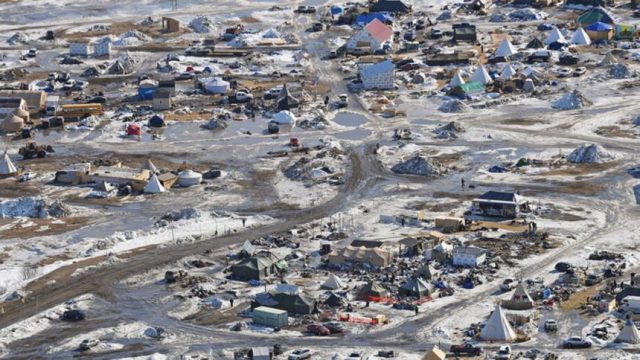Audio: Highway Patrol Spokesman Says #NoDAPL Clean up Is “Not Going to Be Fast Enough”

TOM STROMME/Tribune An aerial view of the main protest camp on U.S. Army Corps of Engineers land at the confluence of the Missouri River and Cannonball River in southern Morton County North Dakota on February 13, 2017. The area is in a flood plain and must be clear of buildings and people who have been illegally camping to protest the nearby Dakota Access Pipeline. This view shows the camp's main entrance road at left with cluster of tents in lower center being the camp headquarters.
“It’s slow moving,” Lt. Tom Iverson of the North Dakota Highway Patrol told me yesterday on my radio show (audio below), “and it’s not going to be fast enough to be honest.”
He was referring to the clean up efforts at the #NoDAPL protest camps in south central North Dakota. The thousands of activists who flocked with North Dakota trespassed on private land, vandalized private property, and used violent and intimidating tactics against law enforcement and the public. And then they left, failing to clean up hundreds of abandoned cars and literally tons of garbage.
With the spring melt of record setting snow falls meaning the flood plain the camp was established on will almost certainly flood, there is an ecological disaster in the offing.
To be fair to Iverson, his gloomy outlook on the clean up came just as news was breaking that the U.S. Army Corps of Engineers would be assisting in the clean up, and before Governor Doug Burgum issued a mandatory evacuation order for that area, but there is also a lot of frustration with slow clean up efforts.
Not to mention activists who still won’t leave the area.
[mks_pullquote align=”right” width=”300″ size=”24″ bg_color=”#ffffff” txt_color=”#000000″]Iverson estimated the population of the camp as of yesterday to be about 280 people, adding that only “some” of them “understand the importance of cleaning up.”[/mks_pullquote]
Iverson estimated the population of the camp as of yesterday to be about 280 people, adding that only “some” of them “understand the importance of cleaning up.”
He also said there are safety concerns for those doing the clean up given the violent tactics protesters have used in the past. “It is going to create some security concerns,” he told me.
I asked Iverson about the abandoned cars, and how so many came to be left at the protest camp. He told me there were likely a lot of explanations for that, including one theory that at least some of them are rental cars left behind when out of state activists abandoned the protest.
Iverson also said he’s concerned about an on-going presence of activists in that part of the state. “What happens if a year from now we’re still coming to these meetings?” he said, referring to law enforcement and other state officials who have been working together to address the camps. One area of concern is the security of the pipeline after the project is completed.
Last year a group of activists, in solidarity with the #NoDAPL protests, broke into secured areas and tried to turn off five major pipelines. Is that a risk for the Dakota Access Pipeline?
“Are there exposed valves on both sides of the river?” he asked. “There has to be something out there.”
Here’s the audio:
[fcc_jw_podcast key=”EvNDivZO” player-image=”135931″]




